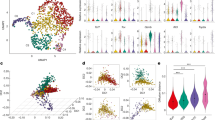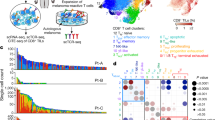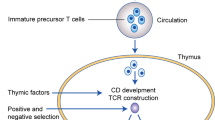Abstract
The vertebrate immune system has evolved to protect against infections that threaten survival before reproduction. Clinically manifest tumours mostly arise after the reproductive years and somatic mutations allow even otherwise antigenic tumours to evade the attention of the immune system1,2,3. Moreover, the lack of immunological co-stimulatory molecules on solid tumours could result in T-cell tolerance4,5,6,7,8; that is, the failure of T cells to respond. However, this may not generally apply9,10. Here we report several important findings regarding the immune response to tumours, on the basis of studies of several tumour types. First, tumour-specific induction of protective cytotoxic T cells (CTLs) depends on sufficient tumour cells reaching secondary lymphatic organs early and for a long enough duration. Second, diffusely invading systemic tumours delete CTLs. Third, tumours that stay strictly outside secondary lymphatic organs, or that are within these organs but separated from T cells by barriers, are ignored by T cells but do not delete them. Fourth, co-stimulatory molecules on tumour cells do not influence CTL priming but enhance primed CTL responses in peripheral solid tumours. Last, cross priming of CTLs by tumour antigens, mediated by major histocompatibility complex (MHC) class I molecules of antigen-presenting host cells, is inefficient and not protective. These rules of T-cell induction and maintenance not only change previous views but also rationales for anti-tumour immunotherapy1,2.
This is a preview of subscription content, access via your institution
Access options
Subscribe to this journal
Receive 51 print issues and online access
$199.00 per year
only $3.90 per issue
Buy this article
- Purchase on SpringerLink
- Instant access to full article PDF
Prices may be subject to local taxes which are calculated during checkout





Similar content being viewed by others
References
Old, L. J. Tumour immunology: the first century. Curr. Opin. Immunol. 4, 603–607 (1992).
Boon, T., Cerottini, J. C., van-den-Eynde, B., van-der-Bruggen, P. & Van-Pel, A. Tumour antigens recogniced by T lymphocytes. Annu. Rev. Immunol. 12, 337–365 (1994).
Braun, S. et al. Cytokeratin-positive cells in the bone marrow and survival of patients with stage I, II or III breast cancer. N. Engl. J. Med. 342, 525–533 (2000).
Schwartz, R. H. Costimulation of T lymphocytes: the role of CD28, CTLA-4, and B7/BB1 in interleukin-2 production and immunotherapy. Cell 71, 1065–1068 (1992).
Townsend, S. E. & Allison, J. P. Tumour rejection after direct costimulation of CD8+ T cells by B7-transfected melanoma cells. Science 259, 368–370 (1993).
Chen, L. et al. Costimulation of antitumour immunity by the B7 counterreceptor for the T lymphocyte molecules CD28 and CTLA-4. Cell 71, 1093–1102 (1992).
Hellstrom, K. E., Hellstrom, I. & Chen, L. Can co-stimulated tumour immunity be therapeutically efficacious? Immunol. Rev. 145, 123–145 (1995).
Matzinger, P. Tolerance, danger, and the extended family. Annu. Rev Immunol. 12, 991–1045 (1994).
Kündig, T. M. et al. Fibroblasts as efficient antigen-presenting cells in lymphoid organs. Science 268, 1343–1347 (1995).
Ochsenbein, A. F. et al. Immune surveillance against a peripheral solid tumour fails because of immunological ignorance. Proc. Natl Acad. Sci. USA 96, 2233–2238 (1999).
Hahn, H. & Kaufmann, S. H. E. Role of cell mediated immunity in bacterial infections. Rev. Infect. Dis. 3, 1221–1250 (1981).
Carbone, F. R., Kurts, C., Bennet, S. R. M., Miller, J. F. A. P. & Heath, W. R. Cross-presentation: a general mechanism for CTL immunity and tolerance. Immunol. Today 19, 368–373 (1998).
Huang, A. Y. et al. Role of bone marrow-derived cells in presenting MHC class I-restricted tumour antigens. Science 264, 961–965 (1994).
Yewdell, J. W., Norbury, C. C. & Bennink, J. R. Mechanisms of exogenous antigen presentation by MHC class I molecules in vitro and in vivo: implications for generating CD8+ T cell responses to infectious agents, tumours, transplants, and vaccines. Adv. Immunol. 73, 1–77 (1999).
Jeannin, P. OmpA targets dendritc cells, induces their maturation and delivers antigen into the MHC class I presentation pathway. Nature Immunol. 1, 502–509 (2000).
Bevan, M. J. Cross-priming for a secondary cytotoxic response to minor H antigens with H-2 congenic cells which do not cross-react in the cytotoxic assay. J. Exp. Med. 143, 1283–1288 (1976).
Toes, R. E. M. et al. Protective antitumour immunity induced by immunization with completely allogenic tumour cells. Cancer Res. 56, 3782–3787 (1996).
Lu, Z. et al. CD40-independent pathways of T cell help for priming of CD8(+) cytotoxic T lymphocytes. J. Exp. Med. 191, 541–550 (2000).
Hermans, I. F., Daish, A., Yang, J., Ritchie, D. S. & Ronchese, F. Antigen expressed on tumour cells fails to elicit an immune response, even in the presence of increased numbers of tumour-specific cytotoxic T lymphocyte precursors. Cancer Res. 58, 3909–3917 (1998).
Prevost-Blondel, A. et al. Tumour-infiltrating lymphocytes exhibiting high ex vivo cytolytic activity fail to prevent murine melanoma tumour growth in vivo. J. Immunol. 161, 2187–2194 (1998).
Staveley-O'Carrol, K. et al. Induction of antigen-specific T cell anergy: an early event in the course of tumour progression. Proc. Natl Acad. Sci. USA 95, 1178–1183 (1998).
Oehen, S. U. et al. Escape of thymocytes and mature T cells from clonal deletion due to limiting tolerogen expression levels. Cell Immunol. 158, 342–352 (1994).
Oxenius, A., Bachmann, M. F., Zinkernagel, R. M. & Hengartner, H. Virus-specific MHC class II-restricted TCR-transgenic mice: effects on humoral and cellular immune response after viral infection. Eur. J. Immunol. 28, 390–400 (1998).
Shahinian, A. et al. Differential T cell costimulatory requirements in CD28-deficient mice. Science 261, 609–612 (1993).
Karrer, U. et al. On the key role of secondary lymphoid organs in antiviral immune responses studied in alymphoplastic (aly/aly) and spleenless (Hox11-/-) mutant mice. J. Exp. Med. 185, 2157–2170 (1997).
Ramarathinam, L., Castle, M., Wu, Y. & Liu, Y. T cell costimulation by B7/BB1 induces CD8 T cell-dependent tumour rejection: an important tole of B7/BB1 in the induction, recruitment, and effector function of antitumour T cells. J. Exp. Med. 179, 1205–1214 (1994).
Maric, M., Zheng, P., Sarma, S., Guo, Y. & Liu, Y. Maturation of cytotoxic T lymphocytes against a B7-transfected nonmetastatic tumour: a critical role for costimulation by B7 on both tumour and host antigen-presenting cells. Cancer Res. 58, 3376–3384 (1998).
Ossendrop, F., Mengede, E., Camps, M., Filius, R. & Melief, C. J. Specific T helper requirement for optimal induction of cytotoxic T lymphocytes against major histocomatibility complex class II negative tumours. J. Exp. Med. 187, 693–702 (1998).
Harlan, D. M. et al. Mice expressing both B7-1 and viral glycoprotein on pancreatic beta cells along with glycoprotein-specific transgenic T cells develop diabetes due to a breakdown of T-lymphocyte unresponsiveness. Proc. Natl Acad. Sci. USA 91, 3137–3141 (1994).
Wu, T. C., Huang, A. Y. C., Jaffee, E. M., Levitsky, H. I. & Pardoll, D. M. A reassessment of the role of B7-1 expression in tumour rejection. J. Exp. Med. 182, 1415–1421 (1995).
Acknowledgements
We thank K. McCoy for critical review of the manuscript and N. Wey for photographs. This work was funded by grants from the Swiss National Science Foundation (to R.M.Z) and the Kanton Zurich.
Author information
Authors and Affiliations
Corresponding author
Supplementary information

Figure 1
(GIF 11 KB)
Comparison of tumor take versus induction of anti-tumor CTL responses after transplantation of minor histo-incompatible tumor fragments.
MC-GP tumor pieces were transplanted into both flanks of C57BL/10 mice. Tumor growth (A) and secondary CTL activity (B) are presented as either growing (s) or rejected (t) tumors, according to the results. The numbers of growing or rejected tumors over the total number of transferred tumor pieces or cell suspensions is indicated in A. GP-33-specific CTL responses were assessed by a 51Cr-release assay after 5 days in vitro restimulation of spleen cells taken 40 days after transplantation of the tumor fragment. CTL activity is given for each group as mean + SD. These results thus demonstrate that growing tumor pieces did not induce a GP33-specific CTL response (B), indicating that strictly peripheral antigens did not induce CTLs even in a situation where minor histoincompatibility antigens may have provided additional CTL-epitopes and/or T help.

Figure 1
(GIF 15 KB)
Immunogenicity of MC-GP versus MC-GP-B7 cells.
(A) We compared the rejection kinetics of H8 splenocytes (GP33-tg H8 mice on the C57BL/6 background 1) expressing the CTL epitope GP33 after priming of C57BL/6 mice with MC-GP and MC-GP-B7 tumor cells in vivo. GP33-transgenic H8 and C57BL/6 control splenocytes were CFSE labeled and 2x107 splenocytes of each were transferred to C57BL/6 mice that had been primed 8 days previously with either 2x106 live MC-GP or MC-GP-B7 cells intraperitoneally. G33-41 expressing splenocytes were labeled with a high intensity of CFSE (5- and 6-carboxyfluorescein diacetate succinimidyl ester, Molecular Probes, Eugene, OR, USA) fluorescence, whereas C57BL/6 splenocytes were labeled with a low intensity of CFSE fluorescence. Mice primed with MC-GP or with MC-GP-B7 cells similarly rejected transfused GP33-expressing H8-splenocytes by 48 hours after transfer. The percentage specific rejection was calculated as described 2. A LCMV day 60 immune mouse was used as positive control. (B) In addition, we also analyzed the stimulatory capacity of GP-expressing tumor cells with or without co-expression of B7 by assessing specific CD8+ T cell expansion after priming with MC-GP or MC-GP-B7 tumor cells. 2x106 splenocytes from a Db plus GP33-specific TCR transgenic mouse (318 mouse 3) were transferred into syngeneic C57BL/6 mice that were additionally treated with 2x106 MC-GP or MC-GP-B7 tumor cells i.p.. The transferred 318 cells were followed by monitoring Vb8.2 (Vb8.2-FITC), Va2 (anti-Va2-PE) and CD8+ (anti-CD8-TRI). A comparable 10-20 fold expansion (14.1+6.3x for MC-GP and 12.8+5.4x for MC-GP-B7) of transferred 318 cells was observed; the kinetics were comparable at 8-12 days after immunization with either tumor cell line. As a positive control LCMV infection caused about a 60-fold (57.2+9.6) expansion (Fig. 4B6). Results are shown as mean + SD of 3 to 4 animals per group. Experiments were repeated twice with similar results.
Together, these results indicate a similar immunogenicity of B7+ and B7- MC-GP cells when assessed in sensitive in vivo readouts.
Reference List
-
1.
Ehl, S., Hombach, J., Aichele, P., et al. Viral and bacterial infections interfere with peripheral tolerance induction and activate CD8+ T cells to cause immunopathology. J Exp.Med. 187, 763-774 (1998).
-
2.
Oehen, S., Brduscha, R.K., Oxenius, A. & Odermatt, B. A simple method for evaluating the rejection of grafted spleen cells by flow cytometry and tracing adoptively transferred cells by light microscopy. J.Immunol.Methods 207, 33-42 (1997).
-
3.
Zimmermann, C., Brduscha-Riem, K., Blaser, C., Zinkernagel, R.M. & Pircher, H. Visualisation, characterization and turnover of CD8+ memory T cells in virus-infected host. J.Exp.Med. 183, 1367-1375 (1996).
Rights and permissions
About this article
Cite this article
Ochsenbein, A., Sierro, S., Odermatt, B. et al. Roles of tumour localization, second signals and cross priming in cytotoxic T-cell induction. Nature 411, 1058–1064 (2001). https://doi.org/10.1038/35082583
Received:
Accepted:
Published:
Issue Date:
DOI: https://doi.org/10.1038/35082583



